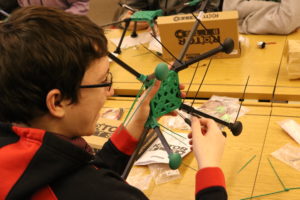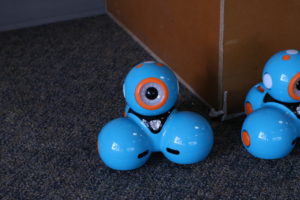
Building electric circuits has been a science-class staple for decades. Using copper wire, a 9-volt battery and a light bulb, students learn about the flow of electricity. That classic lesson is changing as new technologies, such as drones and robots, enter the classroom. KSTK joined Wrangell students as they learned to build drones, program robots and create paper circuitry.
A handful of middle and high school students are gathered in Wrangell High School’s shop to build their very own drones. Plastic pieces lie all over a communal table as students screw and zip-tie their machines’ together.
Junior Zachery Seddon is just finishing his frame and is about to attach small motors to each corner.
“The motors have to be screwed on and we have to solder male and female ends to the motors and the circuitry,” Seddon said.
But, that’s not all students are learning through the Alaskans Transforming Educational Access within Communities and Homes (AKTEACH) program. The correspondence home-school program provides supplemental online courses for school districts around the state.

The Kodiak-based school is trying to use these drones to help students understand the skills necessary to build them, as well as how to fly, practical applications and legal limits.
“There are a surprising amount of restrictions with drones and their uses. You can’t go above 400 feet. You’re not supposed to at least,” Seddon explained.
The program’s Director of Rural Schools, Phil Johnson, hopes the two-day workshop will spark interest in science and technology career paths.
“We want them to recognize that there’s science here. Really our goal is to tie it in,” Johnson said. “We’re teaching them to kind of do the pilot component. Then we want to go through the fabrication component. Then we want to take them into the workflow piece where we do the 3D mapping. They get into more and more and more of the science piece.”
But it’s not all about drones. Wrangell high students are also learning how to program robots and build paper circuitry.
“The station that I’m working with students on is the paper circuitry station,” Nicole Fuerst, the program’s professional development coordinator, said. “They’re learning about conductivity and how to build basic circuits with some simple tools, LED stickers, copper tape and a printed circuit card and a small three-volt watch battery.”
Students are bending copper tape into preprinted patterns on paper with the goal of lighting LEDs the size of a fingernail.
In another room, Homeschool and Correspondence Coordinator Peggy Azuyak is teaching students to program small robots, called Dashes, using apps on an iPad.
“In this event, I’m running the Dash robots, just giving students an introduction to really basic early coding skills,” Azuyak explained. “The students are not actually writing any code for the Dash robots, but they are learning how to give commands, change the settings to make Dash do what they’re told to make them do because later this afternoon we’re hoping that they’re going to be able to have Dash do what they want it to do.”
In the afternoon, students put all they’ve learned into one final test, building a Rube Goldberg machine. They are required to use a Dash robot, light a paper circuit and as a result, pop a balloon.
Several approaches were taken to achieve results. Some activated their robots with a marble landing in a cup on its head, or popped their balloons by taping a plastic fork to the front of its body. At the end of the day, students tested their machines.
“Well the marble is going to come down here, all the way through these and hopefully pop the balloon. There’s tacks on the inside of the cup on top of Dash’s head. So hopefully it will hit it,” one student explained to the rest of the class.
After the marble raced through the marble run, it missed the cup meant to pop the balloon. Like this group, several were unsuccessful.
Fuerst: “If you had more supplies or different choices, what would you do differently next time?”
Student: “Have a bigger marble.”
Wrangell’s students, like many across the country, are being engaged through these science and technology programs, all in the hopes peaking their interest in careers of the future.




